Kanten, or agar, is a gelatinous substance that is essential in Japanese confectionery. Unlike animal gelatin, kanten is a healthy, calorie-free food rich in dietary fiber, being made from seaweed. But the producers of natural kanten are now on the verge of disappearing.
Natural kanten is primarily produced in mountainous areas, where winters are severe and temperatures greatly vary between day and night. Much time and effort goes into its production, which takes place in sub-zero conditions. In the following, we will explore the history of kanten in Japan, its production process, and the effects of mass-manufactured kanten and global warming on the producers of natural kanten .
The History of Kanten in Japan
Tokoroten was popular as a summertime snack in the city of Edo, now Tokyo. Typically served cold in noodle-like strips, it is made by straining the broth of tengusa (Gelidium), then cooling the broth into a gelatinous solid. Kanten , meanwhile, is freeze-dried tokoroten . Tokoroten is said to have arrived from China in the Nara period (710-794), but kanten , with its time-consuming production process, is a Japanese invention.
Kanten was the product of chance. During the Edo period (1603-1868), feudal lords were required to spend alternate years in the capital of Edo, so they had to travel between the capital and their domains every year. On one of these journeys, Lord Shimazu of the Satsuma clan stayed at an inn called Minoya in Fushimi, Kyoto, where he was served tokoroten . The innkeeper, Tarozaemon, left the leftovers outside. The tokoroten froze overnight, defrosted and dehydrated by the next afternoon, and in several days' time it had gone thoroughly dry.
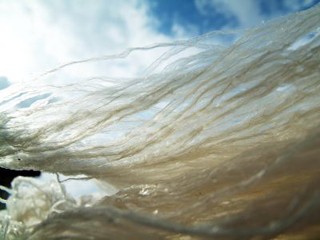
Intrigued, Tarozaemon tried boiling the desiccated mass. It melted, and as it cooled down, it resolidified into a white, translucent jelly without the characteristic smell of seaweed. He went on to study his discovery in depth and eventually marketed it as "dried tokoroten ."
Initially limited to Japanese sweets and other traditional dishes, the use of kanten eventually spread to various purposes, including for microbiological growth media, whisky production, and Western confections. With expanding demand, Japanese kanten was exported worldwide from the Meiji era (1868-1912) onward.
Two areas in Japan are famous for their natural kanten : Ina-shi in Nagano Prefecture, which produces bo (stick) kanten , and Yamaoka-cho in Gifu Prefecture, which is known for ito (string) kanten . I visited Yamaoka-cho, where 90 percent of the ito kanten consumed nationwide is made.
Every winter from November through February, bright white kanten laid out on reed mats line the bare paddies of the serene mountain village. Kanten production began here in the early Showa era (1926-1989). It was purposely introduced so that farms could earn extra income during the winter months. Yamaoka-cho had the perfect conditions for making good kanten : wide temperature differences between day and night and winters as cold as minus 10 degrees Celsius. In the peak year of 1957, Gifu Prefecture alone had 129 kanten producers, most of which were concentrated in Yamaoka-cho.
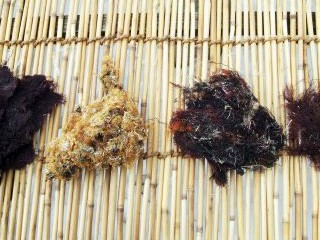
In subsequent decades, however, production of string kanten in Yamaoka-cho dramatically declined. The primary cause was the rise of industrial agar, which could be consistently produced regardless of the weather. Industrial kanten is a powder made by immersing ogonori (Gracilaria), a less viscous kind of seaweed than the tengusa used for natural kanten , in sodium hydroxide to improve coagulation. This agar powder has taken over the mainstream status of natural kanten .
During World War II, Japan banned exports of kanten , which had been an important export commodity until then, because its enemies were using agar-based media to develop biological weapons. Countries that were no longer able to buy agar from Japan then began producing its own agar. Today, trade liberalization has brought in cheap imports from such places as South Korea, China, and Taiwan, which are choking the domestic centers of production.
Another problem is that few young people nowadays eat yokan , a Japanese confection that calls for string kanten of the best grade. Due to the warm winters of recent years, moreover, it has become exceedingly difficult to make kanten by drying them in the sun. All this has led to a serious shortage of people willing to succeed the business of existing kanten producers. Only 11 producers remain in and around Yamaoka-cho.
Kanten is indispensable in the world of Japanese confectionery for the delicate texture that it can create. It is also attracting growing attention as a health food. Being plant based and having no calories-unlike gelatin, which is derived from animal tissue- kanten is considered to be effective for preventing obesity and rectal cancer. But the skills and culture that keep this food alive are now at a crossroads.
Making Natural Kanten : A Labor-Intensive Process
Most of the tengusa (Gelidium) from which kanten is made are of domestic origin. The seaweed comes in dried form, having been sun-dried for about 10 days by fishermen. Although dried tengusa is made across Japan, the supply is limited, relying as it does on small-scale techniques such as underwater fishing and seining. The quality may be high, but so is the price. Gelidium grows in various parts of the world, however, and many quality products are available. Nowadays, wholesalers deal in Gelidium from countries as diverse as South Korea, China, Indonesia, Morocco, South Africa, and Chile.
In Yamaoka-cho, which has been a focus of sales approaches by tengusa producers from across Japan, every kanten producer uses between three and five different kinds of tengusa. The quality and precise combination of the tengusa determines the quality of the final product.
To learn about kanten making in Yamaoka-cho, I visited Marusan kanten , owned by Nobuhisa Miura.
The first step is suishin : soaking tengusa in water. The seaweed is soaked for about 48 hours, with the water being refreshed several times to draw out the salt, as well as to remove seashells, sand, and other impurities. Next, it is rinsed with water. Although river water was used in the old days, it has been replaced with pumped-up groundwater, because the rivers have become polluted with domestic wastewater.
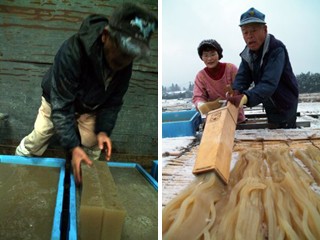
Right: The namaten slabs are split into thin strips using a tenzutsu.
The tengusa is then taken to the boiling room, where it is boiled in cast-iron boilers for about an hour. Only 1 or 2 hours of boiling is needed thanks to the small amount of sulfuric acid that is added at this point; otherwise it would take 12 hours. Some producers also add bleach, as white kanten is generally preferred, but not Marusan kanten .
In the following step, the boiled contents are drained into filtering bags of nylon or linen, and weights are placed on the bags to squeeze out the agar liquid into large tubs called daihune (meaning "barge"). The tengusa remaining in the bag is used as fertilizer for the rice paddies, while the dregs are boiled again.
The filtered material is pumped from the tubs into wooden boxes known as kobune ("small boat") and allowed to coagulate at room temperature for an entire day. The resulting tortoiseshell-colored solids are cut into hard, long slabs called namaten , meaning "raw kanten ," which are carried in the boxes to the drying area outside. Here, one person takes the namaten from the boxes one at a time and inserts it into a device called tenzutsu held by a second person, who thrusts it through the device onto a reed mat. The namaten comes out in the form of thin strips. A third person goes along spreading the strips evenly to ensure that they dry out uniformly and to prevent rotting.
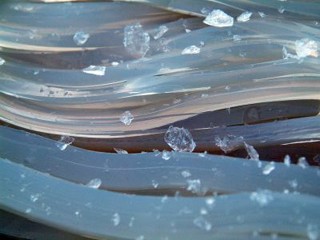
As soon as the temperature falls to 0 degrees Celsius, shreds of ice shaved with a hatchet are sprinkled over the namaten . This step, known as itedori , promotes freezing and yields quality kanten . At times, the producers must wait until midnight to get started. On top of having to cope with the fickle weather, working in the piercing cold is no easy task. The process is repeated three to five times at 10-minute intervals until the strips are thoroughly and evenly frozen.
The namaten are allowed to freeze by night and dry by day for five days to two weeks, depending on the weather conditions. They gradually lose moisture, until they turn into white kanten . Once they begin going white, the producers promote drying by inclining the reed mats toward the sun, a process called kagami . At the same time, the namaten strips are turned over. If snow falls on the undried namaten , it is gently swept off with a broom, and if rain falls after the namaten have dried, they are covered with tarp.
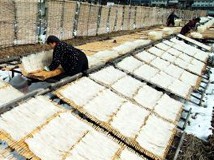
The fully dried kanten strips are skillfully tied into large bundles. They are later screened for dryness, packed, and shipped out.
A scent of ocean drifted through the mountain village as the tengusa was boiled. The rhythmic sound of namaten being thrust through the tenzutsu and the movements of the workers, meanwhile, reminded me of people rowing out to sea. The fact that the namaten containers are called "small boat" somehow seemed to make sense to me. Food can be naturally freeze dried simply by leaving it out in the open air, and yet so much work goes into kanten making. There must be few foodstuffs in the world that are so labor intensive. In particular, the lonely itedori process under the cold winter sky strongly impressed on me the sheer difficulty of making natural kanten . At the same time, I felt it to be a celestial scene in which I glimpsed something of the beauty of kanten as the product of collaboration between humans and nature.
Ideal Conditions for Kanten Production
Yamaoka-cho in Ena-shi, Gifu Prefecture, and its vicinity are famous for cold winters. Here, temperatures can fall to anywhere from minus 5 to 10 degrees Celsius between the end of November and the beginning of March; the namaten would not turn into real kanten if the winter cold were insufficient. Meanwhile, because of its low precipitation, the area gets a lot of sun during the winter, leading to wide temperature differences between day and night. The namaten can thus dry well in the warmth of the afternoon sun, and there are fewer chances of having to evacuate the namaten indoors every time to protect it from snow or rain.
These are the conditions that define a place suited for kanten production. The Tanba area in Hyogo Prefecture, where kanten is still made, and Chino-shi in Nagano Prefecture, whose history with kanten is older than Yamaoka-cho's, both fulfill the conditions described above.
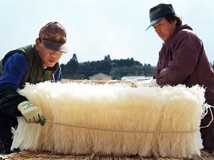
One thing that concerned me during the visit was the effect of global warming on the kanten business. "Until thirty years ago, it used to sometimes reach ten degrees below zero, and we would skate on the frozen rivers," says Miura. "But nowadays it rarely gets to be five degrees below zero, and the amount of snow has really gone down, too." What is more, the weather has become more fickle than ever, suddenly pouring on a sunny day, or not snowing when it should, only to snow heavily at the wrong time. The unpredictable weather has increased the labor involved in kanten making. Miura worries that, in five years, the warm winters will have further cut down on the number of producers.
Kanten production was introduced in Yamaoka-cho in 1921 to save farms from the plight brought about by a crash in cocoon prices. Under the guidance of Tetsukuro Oguchi, an engineer, three youths jointly founded the Mitsuiwa kanten Seizosho (Mitsuiwa kanten Plant). With dwindling rice prices, many farms also embarked on kanten making, until in 1955 the number of producers peaked at 129 in Gifu Prefecture alone, 80 percent of which were based in Yamaoka-cho.
Today, however, a mere 11 producers remain in the village. Even the nationwide total is only about 15.
The sight of stark white kanten being dried in the wintry fields may soon become a thing of the past if industrial agar, imported kanten , and natural domestic kanten are all lumped together under the same name. The first step in protecting this tradition is for us consumers to fully understand its value.
Photos: Hiroaki Horiguchi
